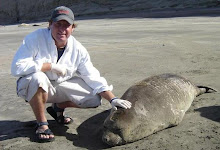Melbourne, Florida. This past weekend, after spending some great time up in the wilds of the Santa Monica Mountains as well as working on a funny, new show called Party Down, I hopped on an airplane at LAX and headed to Melbourne, Florida. This is where Boca lives and where I’ll be spending the next couple of weeks, laying low and working on some writing projects.
Boca’s house, tucked off Route One in a forgotten hamlet alongside the Indian River Lagoon, is a throw-back to Old Florida; the Florida of Jimmy Buffet songs and wild, sometimes wacky pioneer spirits. How this hideaway has escaped the malignant condos and strip malls now universal along this coast, I don’t know. But there is a peace here, and in these first days of the Obama administration, there is hope – a green, sustainable hope.
Rather than condos, track homes, or the stately mansions of Palm Beach, the houses of Boca’s neighborhood are little more than wooden shacks, all built in the quaint Key West style with tin roofs, wide front porches and nestled within a bramble of subtropical vegetation. I’ve been taking a daily walk through the unpaved, limestone streets of the neighborhood. The road runs along the water, where abundant ibis, egrets, herons, wood storks and other water fowl wade in the shallows alongside the mangroves. Manatees are also common here. And yesterday, while exploring these wetlands, I discovered a man living among the trees. He has a tent, bookshelves and even paintings hanging from the entangled branches of the red mangrove. But these are not the stately mangroves of the Florida Keys – much less the towering giants one can see in Ecuador. But rather, they are squat, mushroom-like dwarf cousins, pushing the limits of their range into the colder north. Yet despite being nearly a two hour drive up coast from South Florida and its Caribbean-linked vegetation, the feeling here is still more tropical than not. Boca’s yard itself is a brambly, overgrown jungle full of strangler fig-encrusted sabal palms, live oaks adorned in Spanish moss, and a wiry maze of ferns, citrus, epiphytic cacti, a few subtropical hardwoods and rosary pea vines, which shed their painted seeds on my path as if taunting me with memories of tribal necklaces of the Amazon. There is also a kapok tree (Ceiba pentandra). Not a native or even usually found this far north; it is the only one we know of around here. It was grown from a seed that I took from its mother tree, a massive kapok giant on the island of Antigua. This was back in 1993 and now the sapling kapok is well on its way to rising above all else in the neighborhood. There are also little anole lizards darting around your feet, bromeliads on the branches of trees and a family of raccoons that has been known to grab steaks right off the grill if you don’t keep a sharp eye.
This is the Florida that once was and is rapidly disappearing. But the hope I mentioned is here. The city of Melbourne recently purchased a substantial piece of property just down the road and converted it into a waterfront green area, thus maintaining those fig entangled palms and the waterfront shacks that sleep in their shade. And just across the lagoon is Melbourne Beach, where citizens recently elected biologist Rita Karpie as town mayor, whilst running on a completely green platform. This is progress for a state better known for draining swamps and killing gators than for sustainability and forward thinking. All is not lost. The natural history and the old ways of Florida are still here, ready to expand out and repopulate the land once the people are ready. I will enjoy these next couple of weeks. I will enjoy these Floridays.
23 January, 2009
19 January, 2009
Hope in the New Year
Santa Cruz, California.
Labels:
Arlo Hemphill,
California,
Hope,
New Year,
Pacific Ocean
Subscribe to:
Posts (Atom)


